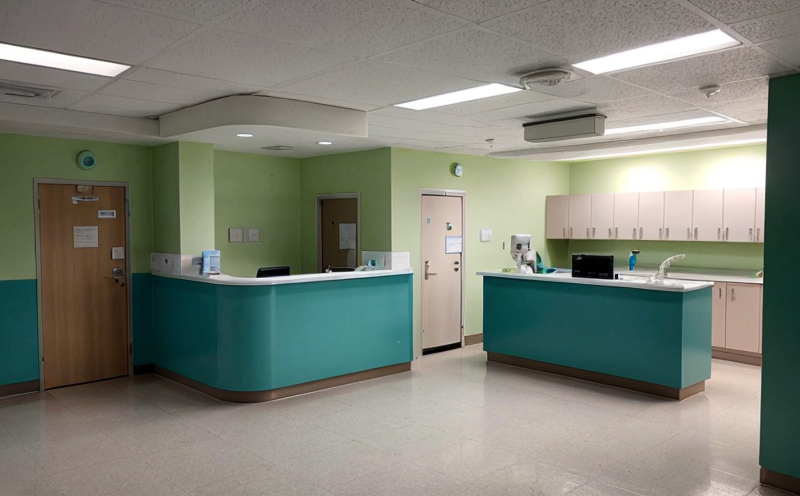USP Sterility Testing in Hospital Pharmacy Preparations
The USP sterility testing is a critical component of ensuring the safety and efficacy of hospital pharmacy preparations. This test is designed to detect the presence of viable microorganisms that could compromise the integrity of sterile pharmaceutical products. In healthcare settings, where even minimal contamination can lead to severe health risks, the importance of this testing cannot be overstated.
Pharmacy preparations are often formulated in aseptic environments, and the process must maintain sterility from raw materials through final product delivery. USP testing ensures that these preparations remain free from microorganisms throughout their shelf life. The test is conducted using a method called the membrane filtration technique (MFT), which involves filtering samples to capture any potential contaminants.
The procedure typically follows these steps:
- Preparation of the sample for testing
- Filtration through MFT membranes
- Culture of the collected filtrate on appropriate media
- Incubation and observation of growth (or lack thereof)
- Documentation of results according to USP guidelines
The test is particularly crucial for injectable drugs, ophthalmic products, and other preparations where even a single viable microorganism could lead to serious adverse effects. Compliance with USP standards ensures that healthcare providers can trust the sterility of these vital medications.
In addition to ensuring product safety, sterile testing also supports broader quality control efforts within hospital pharmacies. It helps in identifying any breaches in aseptic technique or potential contamination issues early on, allowing for corrective actions before they affect patient care.
Why It Matters
The significance of USP sterility testing extends beyond mere compliance; it plays a vital role in maintaining the highest standards of patient safety and healthcare quality. In hospital pharmacies, where medications are prepared for direct administration into patients' bodies, the risk of microbial contamination is particularly high.
Contaminated products can lead to severe infections and other adverse reactions, which not only jeopardize individual patient health but also strain healthcare resources. By adhering to USP , hospitals demonstrate their commitment to providing safe and effective medications that meet rigorous international standards.
The test is crucial for ensuring consistency in quality across all batches of prepared pharmaceuticals. It helps pharmacists maintain confidence in their products, which is essential for trust between healthcare providers and patients. Moreover, compliance with USP fosters a culture of continuous improvement within the pharmacy department, encouraging staff to adopt best practices and innovative solutions.
In summary, USP sterility testing is more than just a regulatory requirement; it is a fundamental pillar in safeguarding patient health and enhancing overall healthcare delivery. By prioritizing this test, hospitals can contribute significantly to reducing the incidence of nosocomial infections and other adverse events associated with contaminated medications.
Environmental and Sustainability Contributions
The practice of USP sterility testing in hospital pharmacy preparations also has broader implications for environmental sustainability. By ensuring that pharmaceutical products are free from microbial contamination, hospitals can minimize the risk of waste generation due to ineffective or contaminated medications. This leads to more efficient use of resources and reduces unnecessary healthcare costs.
The testing process itself is environmentally friendly when conducted with proper techniques and protocols. The use of advanced filtration methods ensures minimal waste production, while the careful handling of samples prevents cross-contamination that could lead to additional testing requirements. Furthermore, compliance with USP helps hospitals align their operations with sustainable healthcare practices recommended by global health organizations.
In addition to reducing waste and resource inefficiencies, USP sterility testing also supports the development of greener pharmaceutical processes. By identifying and eliminating sources of contamination early in the production cycle, hospitals can adopt more sustainable manufacturing techniques that reduce environmental impact without compromising product quality.
The commitment to USP sterility testing not only enhances patient safety but also promotes a more environmentally responsible healthcare system. This aligns with broader sustainability goals aimed at creating healthier communities and reducing the ecological footprint of medical practices.
Competitive Advantage and Market Impact
- Innovation Leadership: Hospitals that adhere strictly to USP standards can position themselves as leaders in innovation and quality. This sets a benchmark for other healthcare providers and enhances their reputation.
- Patient Trust: By ensuring the sterility of all pharmacy-prepared medications, hospitals earn patient trust and loyalty, which is crucial in today’s competitive healthcare market.
- Regulatory Compliance: Staying ahead of regulatory changes ensures that healthcare providers maintain their certifications and avoid costly penalties.
- Operational Efficiency: Early detection of contamination through USP testing allows for timely corrective actions, reducing the need for rework or recalls, which can be time-consuming and costly.
The ability to demonstrate compliance with stringent international standards like USP provides a distinct advantage in the market. Hospitals that excel in this area are more likely to attract top-tier clients and partners, thereby enhancing their overall competitive position. Moreover, adherence to these standards can open doors to new markets and partnerships, further boosting business growth.
In conclusion, the implementation of USP sterility testing is not just a compliance exercise; it’s an investment in patient safety, operational efficiency, and long-term market success. By prioritizing this service, hospitals can build sustainable competitive advantages that contribute to their enduring success in the healthcare industry.





